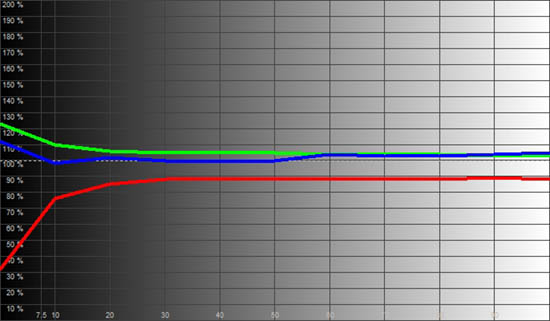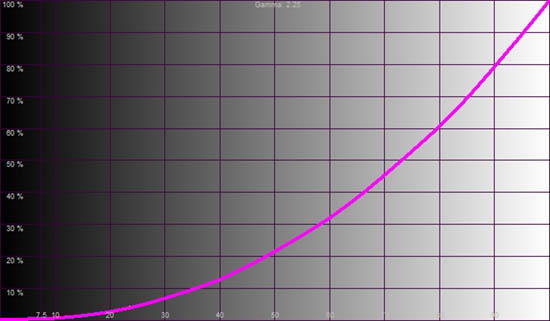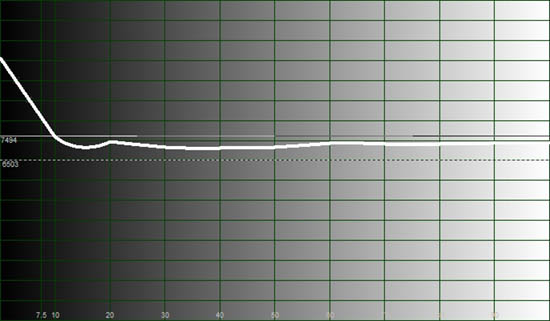I measured the color gamut of the display, and the
color range corresponds quite similarly to other PDPs, with the usual lack
of blues and a wider range of greens than necessary.

Gamma measured quite accurately. When the plasma is set
to gamma 2.2, the graph measured 2.25 and was very clean and precise (none
of the typical S-curve bumps). At its 2.4 setting, the display produced a
2.6 measurement (quite surprising, as most displays overestimate the real
graph!).

The default color temperature values come up short on
reds (ideal setting is "Low"), which cause the temperature to average out at
slightly above 6500K (6800K – 7000K). Since this lack of reds is quite
uniform across the entire IRE range, the red bias setting fixes this quite
easily. I did not fully calibrate the unit, but a few small tweaks on red
bias (not shown here) did stabilize the display at around 6500K.

The remote is the typical impractical elongated NEC
remote, but with discrete access to almost all of the important functions.
This allows a macro based remote (like Nevo SL or Pronto) to easily control
it in a smart HT environment.
The display supports several picture memories that can be toggled. This
allows for several calibrations to be used, including day/night modes and
support for different input devices. I find this feature quite useful when
doing calibrations, but I believe most owners will never know it's there.
NEC dedicated quite a lot of thought to the anti-burn
features of the screen, including orbiting, inverse, wiper, and soft focus.
This is quite similar to most PDPs these days.
The aspect ratio control supports many aspect ratios and zoom options (like
Letterbox, Anamorphic, 4:3, and Stadium). The Stadium aspect ratio is
intended to allow 4:3 content to be shown on the 16:9 screen without losing
too much information on the top or bottom of the image. This is done by
slightly trimming the image and then slightly warping the rest of the image.
It's accomplished quite gently and prevents the usual sea sickness one can
get from such features during horizontal camera pans. CNN-style tickers make
this feature more pronounced and gain a slight "fisheye" aspect to them, but
normal TV content is usually OK.
In terms of picture quality, except for the grain one gets up-close, the
display does a magnificent job. An outboard scaler (an iScan HD+) did
improve the picture quality with SD content (particularly NTSC), but the
inherent film mode support in the display worked quite nicely, and details
were maintained in the DVE test and demonstration sequences.
The DVE test sequence with the sun rising across dark
mountains is a great test for showing ANSI contrast issues – the average
brightness of the scene changes dramatically, and the dark mountains need to
stay detailed and uniform through the sequence. This is done fantastically
well with the 42XR4, which handles the scene beautifully. The test sequence
was performed using an Oppo 971H DVD player upscaling to 720p as well as
through its analog component inputs (for de-interlacing tests).
HD content appeared amazing on the 42XR4, and a 1080i version of The
Fifth Element brought out amazing details. My usual test sequence, of
Lilu running across the tunnel (an adjacent scene to the infamous red button
sequence) shows both detail in the tunnel, and works equally as well when
she is finally faced with the modern city in all its detail and highlights.
Of course, the display image is not 1080, or even full 720 (1280x720), but
the down conversion results in a very good picture.
NEC invested quite a bit of an effort in the PIP features on the 42XR4. The
usual PIP and side-by-side are, of course, supported here. However, a real
treat comes in the shape of transparent PIP. This allows you to control not
only where the PIP block appears on the image and how big it will be, but
also how transparent it will be (in 10% increments). It is also possible for
the display to turn off PIP when it sees no signal at all in the PIP input.
This allows you to do tricks like hooking up an outdoor camera that shows up
on the screen when someone walks across the yard or rings your downstairs
doorbell.
Conclusions
Overall, this is an impressive display by NEC. The two main faults I found
with it were the lack of native resolution (dot by dot) support at rates
other than 60 Hz (72 Hz, 50 Hz, and 75 Hz would have been a pleasant
surprise), and the high amount of grain that appears due to the pixel
modulation technique that NEC is using on this particular panel.
- Ofer LaOr -